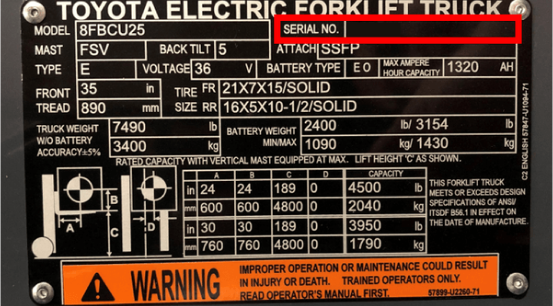How to Find Your Equipment Model Number.
Finding the right parts for your equipment is easy when you have your model and serial number which can be found on the data plate. Luckily, a forklift data plate is installed on every truck on the market to help you understand what your forklift can do and provide vital information.
Model Number: The model number of your toyota forklift is extremely important for relaying information to your dealers about repair or technical assistance and for looking up replacements part!
Serial Number: The serial number on your lift is the most important number.The model serial number combination will allow us to provide you with the parts that will fit your particular piece of equipment.

How to Find Your Equipment Serial Number
Finding the right parts for your equipment is easy when you have your model and serial number which can be found on the data plate. Luckily, a forklift data plate is installed on every truck on the market to help you understand what your forklift can do and provide vital information.
Model Number: The model number of your toyota forklift is extremely important for relaying information to your dealers about repair or technical assistance and for looking up replacements part!
Serial Number: The serial number on your lift is the most important number.The model serial number combination will allow us to provide you with the parts that will fit your particular piece of equipment.

Need some help? For further assistance or more information, contact your local Toyota Dealer.

Please click below to sign in to your MyToyota account
Don't have an account?
Calculating Forklift Aisle Width Minimums

Purchasing the right forklift for your operation requires that you take into account several factors that are unique to your situation. From determining the right rated capacity you’ll need to understand the difference between pneumatic and cushion tires, there’s a lot to consider. And the actual physical space of your workplace can’t be forgotten. You will also need to know what the minimum aisle width for your forklift will be.
Calculating the forklift minimum aisle width will help you make an informed decision about what warehouse forklifts to acquire. But how do you know how much space you’ll need to effectively navigate?
How Wide Does A Forklift Aisle Need To Be?
You should always check your calculations with a certified Toyota dealer, but you can use this simple formula to help you get started in determining how much aisle space your forklift will need.
- Take the Basic Right Angle Stacking Width
- Add the Load Length
- Add 12 Inches of Clearance
The basic right angle stacking width measurement is the smallest amount of space a forklift needs to be able to turn and enter a pallet. It does not include the length of the load that is picked up or any room for clearance. Basic Right Angle Stack measurements are listed in specification manuals. Toyota lists this spec for all of its models on each model’s specific product page.
Load lengths will vary depending on your unique circumstances, and you should always be sure to know your forklift’s rated capacity at certain load centers. But a rule of thumb that might be used as a starting point would be a standard pallet, which is 48 inches in length.
Calculating 12 inches of clearance will help to ensure you have enough space to accommodate your forklift’s turn radius, so you can turn in the aisle and help protect against potentially unsafe situations resulting from operator error.
Basic Right Angle Stacking Width + Load Length + 12 Inches = Your Minimum Forklift Aisle Width
Forklift Aisle Width Calculation Example:
Let’s say you’re considering purchasing a Toyota Core IC Cushion Forklift for your warehouse and want to make sure you would be able to turn in your aisles with a standard pallet. According to the forklift specs, the model you are considering has a Basic Right Angle Stack spec of 86 inches.
86 in. (Basic Right Angle Stacking Width) + 48 in. (Load Length) + 12 in. (Clearance) = 146 in. Minimum Aisle Width
Remember that this is just a start to your assessment practice. Always be sure to have your forklift dealer verify your results before you make a purchasing decision!